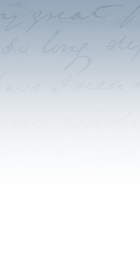A History of Bishop Chase's Papers
Philander Chase, along with being a missionary, bishop, teacher, college president, farmer, and a pioneer, was also a careful record-keeper. Chase knew full well the value of documents to the study of history; and he realized that his life's work might be studied by future historians. We can see this quite clearly in his Reminiscences, which Chase based on old correspondence, journals, as well as his long memory. The two-volume memoir tells not just the story of Chase's life, but is a careful and detailed record of his work.
Gilead, Dec. 23d, 1835
My Dear Husband,
We were all made happy the night before last by receiving your letter from Portsmouth...
Last Saturday night, we went to bed in apparent security, but about twelve o'clock, a slight noise, like the kindling of a fire in a stove, startled me.
I sprang from bed, and throwing open the dining-room door, saw the flames had burst from the upper part of the chimney into the garret. The cry of fire instantly assembled all the family. A tub of water was in the kitchen, and three pailsful, in as many seconds, were thrown on. It was, I saw, in vain; the fire had seized the roof, and bid them lose no time, but throw out as fast as possible. No noise or lamentation was heard; all was rapid as the flame. My first care was your sermon-box, and then the box of English letters, with your letters to myself from England, certificates, and three hundred dollars in money, received for sales of cattle...
As ever, your affectionate wife,
S.M. Chase
Obviously, Bp. Chase placed a great deal of value on his letters-- both those he received, and those he sent (of which he would always make a personal copy), as well as his other papers, and Sophia knew this.
This is also apparent through the Chase's frequent annotation of letters he received. One such letter is from his brother, Baruch, on which Chase noted, "This is the last letter that Baruch wrote." Also, and much to the editors' delight, Chase listed, on each manuscript sermon, when and where it was preached (some having ten or fifteen dates and places), as well as what textual changes were made, and when he made them.
Because of Chase's extensive travels and constant letter writing, Chase manuscripts are located in a wide variety of places-- from Gredington, England (the home of the Lords Kenyon), to dozens of tiny parishes in upstate New York. Upon his death in 1852, the bulk of his papers remained within the family. Many of his publications relating to Kenyon and Jubilee Colleges had already found a home within college and church records collections. When Jubilee closed, the college records were dispersed among the Illinois State Historical Society and the Episcopal diocese.
As years and Chase family members passed, most of the bishop's papers were donated to various institutions. Two of the largest collections, those of Emeline Chase and Alice Chase were donated to Kenyon College in the first half of the twentieth centuries. Another large collection, that of Virginius Chase, was donated to Bradley University in Peoria, Illinois, very near the now historic site of Jubilee College. Other, smaller collections and individual items were donated to a number of institutions.
Although the various collections of Chase's papers have been used in histories of Jubilee and Kenyon Colleges, and in Laura Chase's biography of her grandfather, the collections have seen little scholarly use (and certainly no one has ever attempted to use the entire corpus of Chase's papers). Even Chase's published works, which are only slightly more easy to locate, have remained virtually untouched. Perhaps this is because substantial portions of them (like the Kenyon collection) are largely unorganized and uncatalogued. Or perhaps the daunting task of locating all of the papers of someone who is not a Washington or a Jefferson has discouraged their use. Both of these factors have already provided us with ample challenge.
Since the initiation of the Chase project, interest in Bp. Chase's papers has already increased. We've already received queries from distant relatives of Chase, as well as a descendant of Lord Gambier, and numerous Kenyon and Jubilee-related folks interested in learning more about Kenyon's founder . Moreover, publicity from the project has located numerous Chase documents that most likely would not have been located otherwise.
Certainly, the history of Bp. Chase's papers is far from complete. Hopefully, the project will continue to spark interest and the papers will see the scholarship the so rightly deserve.

